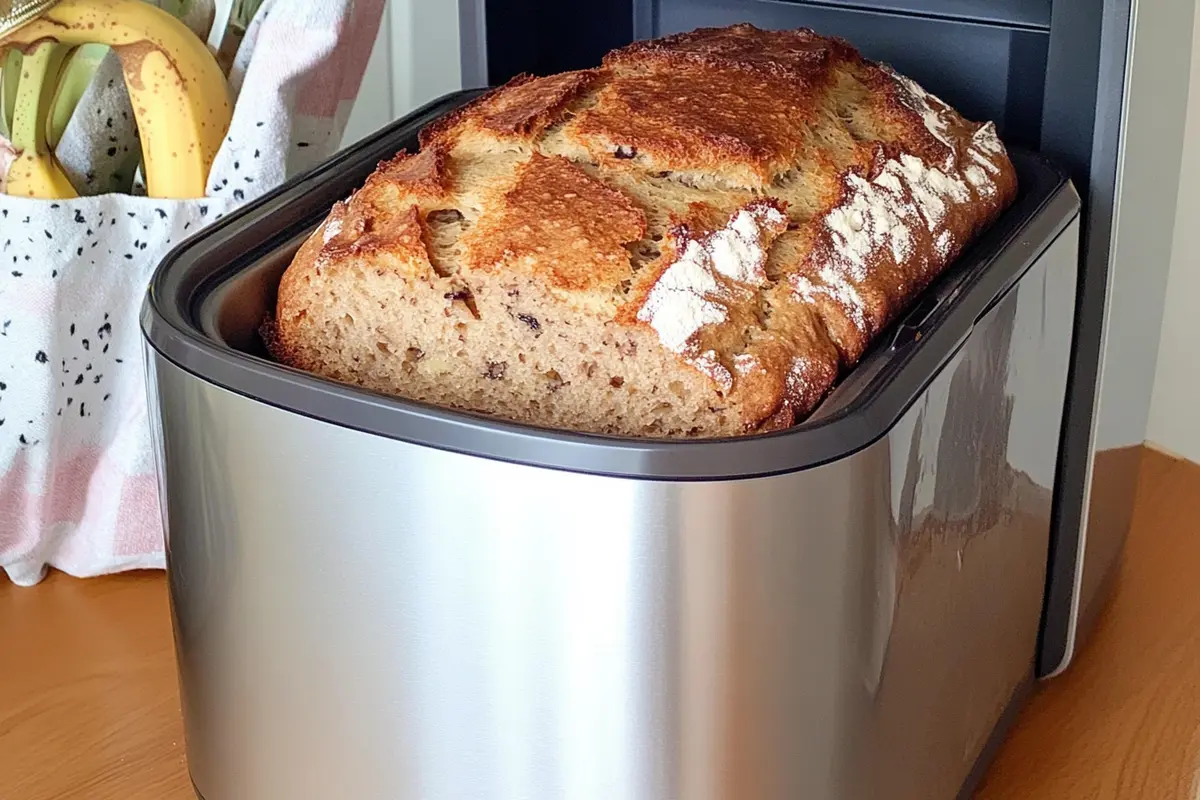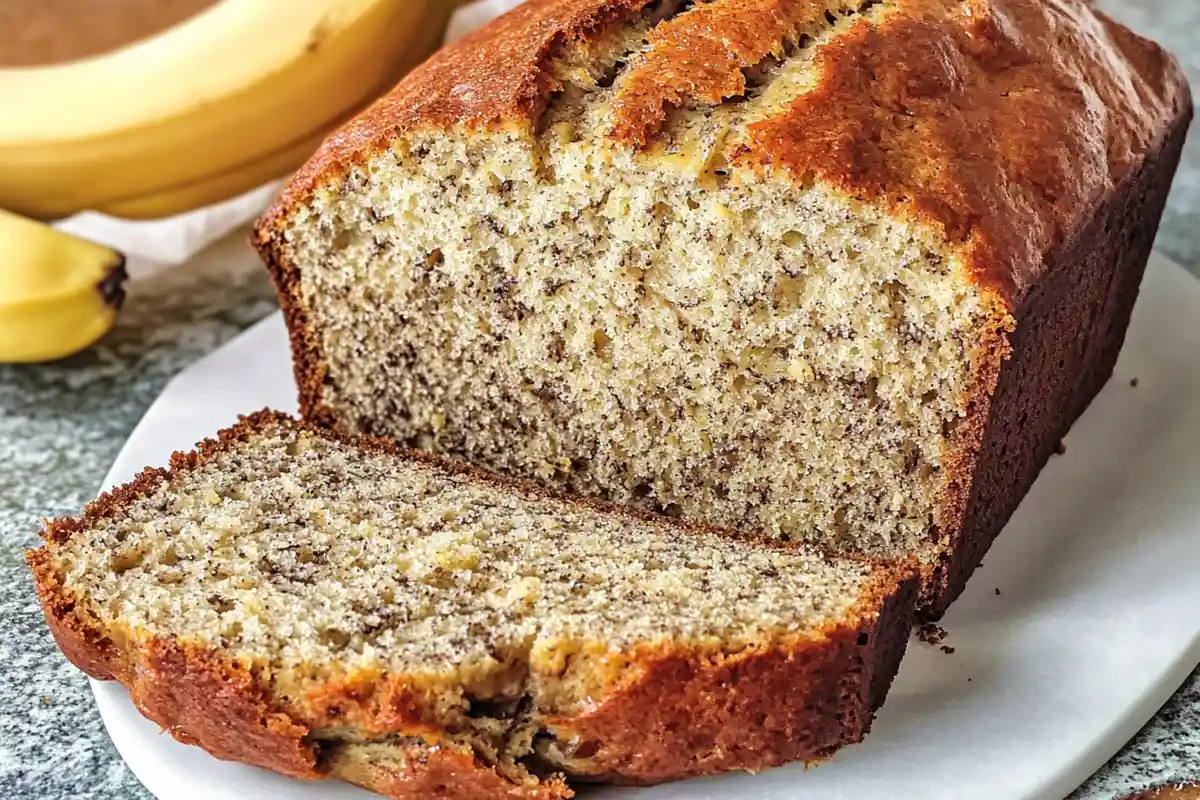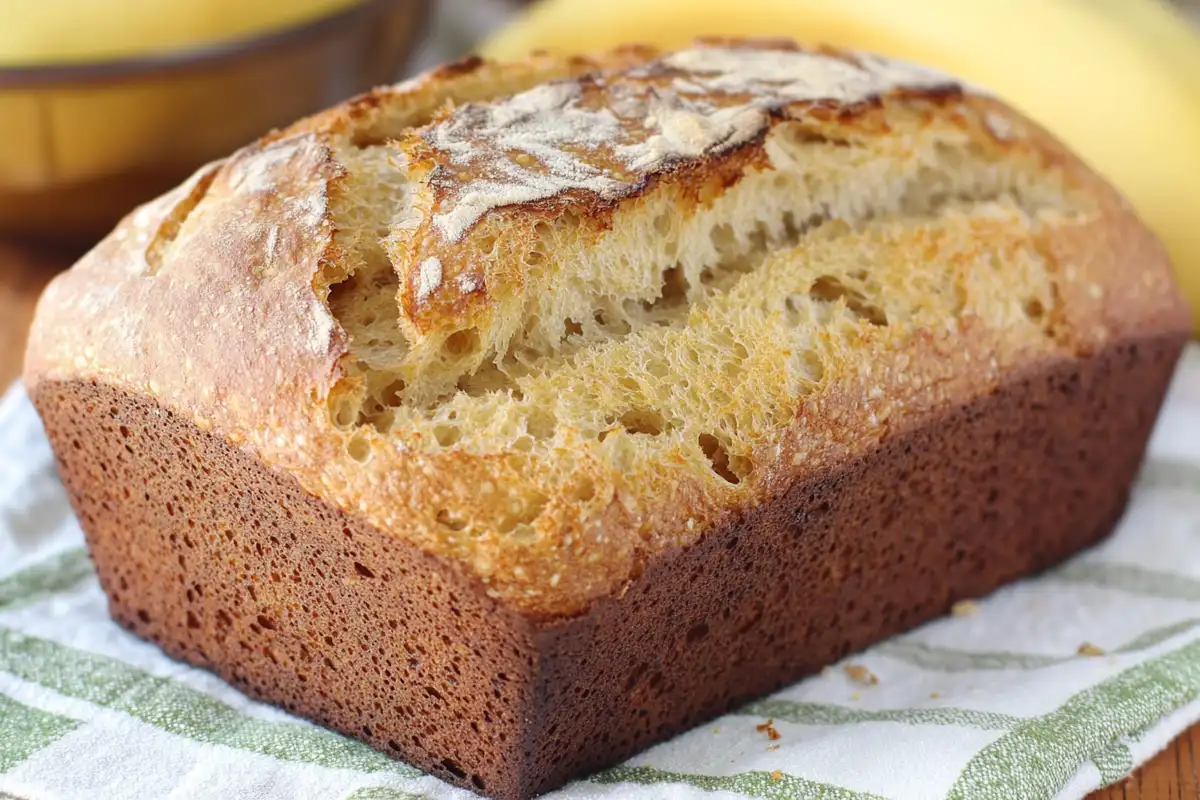What Makes Bread Machine Banana Bread Unique?
Bread machine banana bread offers a delightful twist on the traditional oven-baked version, utilizing technology and precision to streamline the baking process. Its uniqueness stems from the interplay of modern baking science and the distinctive characteristics imparted by bread machines.

The Science of Bread Machine Baking
Bread machines are marvels of culinary technology that automate the baking process, combining precise temperature control, timed mixing, and kneading to create consistent results. Here’s how they affect banana bread:
- Consistent Mixing and Kneading:
- Bread machines are designed to thoroughly mix ingredients, ensuring even distribution of banana pulp, sugar, and flour.
- Unlike manual mixing, the machine prevents overmixing, which can result in tough bread.
- Controlled Temperature:
- Bread machines maintain optimal temperatures for proofing and baking, critical for even cooking.
- For banana bread, which is a quick bread and doesn’t rely on yeast, the consistent heat ensures a uniform crumb.
- Moisture Retention:
- The enclosed environment of a bread machine helps retain moisture, yielding a softer and denser loaf compared to oven baking.
- Simplified Process:
- Bread machines combine steps like mixing, kneading, and baking into a single operation, reducing the chances of error.
- Ideal for beginners, the pre-programmed settings allow even inexperienced bakers to achieve high-quality banana bread.
Comparing Bread Machine Banana Bread with Traditional Oven-Baked Recipes
While both methods can produce delicious banana bread, they differ in texture, flavor, and convenience:
- Texture:
-
- Bread Machine: The loaf tends to be denser and moister due to the closed environment and controlled baking process.
- Oven-Baked: Oven-baked banana bread often has a more open crumb and a slightly firmer crust.
- Flavor Development:
-
- Bread machine banana bread develops a more uniform flavor since the ingredients are well-integrated during the automated mixing cycle.
- Oven-baked banana bread might have a more caramelized crust due to direct heat exposure, adding a slight nutty note.
- Convenience:
-
- Bread machines eliminate much of the guesswork, offering a “set-it-and-forget-it” approach.
- Oven baking requires more hands-on steps, including monitoring the batter, greasing pans, and adjusting baking times.
- Versatility:
-
- Traditional recipes allow for more customization in terms of shapes and toppings, such as streusel or nuts, which might be challenging in a bread machine.
- Bread machines are best suited for straightforward banana bread recipes with minimal add-ons.
- Time Efficiency:
-
- Bread machines automate the entire process, from mixing to baking, reducing active cooking time.
- Oven baking can be quicker in total duration since bread machines often run on longer cycles.
Why Choose Bread Machine Banana Bread?
Bread machine banana bread is perfect for those who prioritize convenience, consistency, and a moist, soft loaf. It simplifies the process for busy bakers and ensures reliable results, making it a popular choice for everyday baking. While traditional methods provide greater flexibility and a rustic charm, the precision and ease of a bread machine make it a compelling alternative for anyone seeking delicious homemade banana bread with minimal effort.

Essential Ingredients for Bread Machine Banana Bread
Creating delicious banana bread in a bread machine requires attention to key ingredients. Each plays a vital role in the flavor, texture, and success of the bread. To ensure the best results, it’s important to carefully select and balance these components. Below, we’ll explore the essentials in detail.
Selecting the Right Bananas
Bananas are the centerpiece of banana bread, providing moisture, sweetness, and flavor. Therefore, choosing the right bananas is critical.
- Ripeness Matters:
-
- To begin with, use overripe bananas with brown or black spots on their peel. These bananas are not only naturally sweeter but also easier to mash, which enhances the bread’s flavor.
- On the other hand, avoid underripe bananas, as they lack the necessary sweetness and soft texture for a successful loaf.
- Mashing Tips:
-
- Furthermore, mashing bananas thoroughly before adding them to the bread machine ensures even distribution. This prevents clumps and contributes to a smoother texture.
- However, if you prefer a chunkier loaf, leave some small banana pieces intact. Keep in mind, though, that larger chunks might not cook evenly in a bread machine.
- Freezing Option:
-
- If your bananas are overripe but you’re not ready to bake yet, you can freeze them for later use. Once thawed, remember to drain any excess liquid before incorporating them into the recipe.
Flour Types and Their Effects
Flour significantly impacts the texture and structure of your banana bread. For this reason, choosing the right type is essential.
- All-Purpose Flour:
- All-purpose flour is a versatile choice, offering a balanced texture that’s ideal for quick breads like banana bread. It produces a tender, moist loaf without being overly dense.
- Whole Wheat Flour:
- For those seeking a nuttier flavor and denser texture, whole wheat flour is a great alternative. That said, using it exclusively can make the bread heavier. To achieve a lighter texture, consider blending it with all-purpose flour in a 50/50 ratio.
- Bread Flour:
- Bread flour, which is higher in protein, creates a chewier texture. While it’s not typically ideal for banana bread, it can work if you prefer a more structured loaf.
- Gluten-Free Flour:
- If you’re baking for a gluten-free diet, be sure to use a gluten-free flour blend designed for baking. Additionally, adding a binding agent like xanthan gum helps prevent the bread from crumbling.
Sweeteners: Sugar, Honey, or Alternatives
-
- Sweeteners are essential for enhancing the flavor of banana bread. They also contribute to the loaf’s golden-brown crust. Depending on your preferences, you can choose from several options.
- Granulated Sugar:
-
- Granulated sugar is the classic choice, delivering consistent sweetness. White sugar provides a clean flavor, whereas brown sugar adds a hint of molasses, resulting in a richer taste.
- Honey:
-
- Honey, as a natural sweetener, not only imparts a floral note but also adds extra moisture. To substitute, use about ¾ cup of honey for every 1 cup of sugar, and reduce other liquids slightly to balance the moisture content.
- Maple Syrup or Agave Nectar:
-
- These liquid sweeteners each bring unique flavors. For example, maple syrup offers a warm, caramel-like taste, while agave provides a lighter sweetness. However, adjustments to the recipe’s liquid ratios may be needed.
- Stevia or Other Low-Calorie Sweeteners:
-
- For those reducing sugar, stevia and similar sweeteners are excellent alternatives. Nonetheless, since they don’t caramelize, the bread might lack the traditional golden crust. Always follow specific conversion guidelines for these highly concentrated sweeteners.
- Mashed Bananas as a Sweetener:
-
- Overripe bananas can also serve as a natural sweetener, partially or fully replacing sugar. Simply add an extra banana for every ½ cup of sugar you substitute.
Key Tips for Bread Machine Success
- Ingredient Order:
-
- Always add wet ingredients (like milk, bananas, and eggs) first, followed by dry ingredients (such as flour and sugar). Place the yeast or leavening agent last to prevent premature activation.
- Moisture Balance:
-
- Since bananas and liquid sweeteners add moisture, adjust the flour or reduce other liquids to avoid an overly dense loaf.
- Customization:
-
- Finally, feel free to add extras like nuts, chocolate chips, or spices (e.g., cinnamon or nutmeg) for variety. However, limit the quantity to avoid overwhelming the bread machine.
By carefully selecting and balancing these essential ingredients, you can create banana bread that is consistently moist, flavorful, and perfectly baked. Whether you’re a seasoned baker or a beginner, these tips will help ensure success every time.
Step-by-Step Bread Machine Banana Bread Recipe
Making banana bread in a bread machine is simple and rewarding, especially when you follow the correct steps. With some preparation and attention to detail, you can enjoy a moist and flavorful loaf without much effort. Below is a step-by-step guide, including preparation tips and the proper order for adding ingredients, to ensure perfect results.
Preparation Tips
- Choose the Right Bananas:
-
- First and foremost, use overripe bananas with dark, speckled skins, as they are sweeter and softer. This enhances the bread’s flavor and moisture.
- If you have underripe bananas, consider ripening them quickly by placing them in a paper bag with an apple for a day or two.
- Set Up the Bread Machine:
-
- Before you start, check that your bread machine has a “Quick Bread” or “Cake” setting, as these are specifically designed for non-yeast recipes like banana bread.
- Additionally, ensure the bread pan is clean and properly inserted into the machine.
- Measure Ingredients Accurately:
-
- Baking requires precision, so always use proper measuring cups and spoons. For example, level off dry ingredients with a knife to avoid adding too much flour, which can make the bread dense.
- Prepare Add-Ins in Advance:
-
- If you plan to include nuts, chocolate chips, or dried fruits, measure and prepare them ahead of time. This helps streamline the process when you’re ready to add them.
Adding Ingredients in the Correct Order
Adding ingredients in the proper sequence is critical for bread machine success. By layering them correctly, you ensure even mixing and baking.
- Start with Wet Ingredients:
- Begin by adding the wet ingredients to the bread pan:
-
-
- 2-3 mashed bananas (approximately 1 cup): These should be mashed thoroughly for even distribution.
- 2 large eggs, lightly beaten, to bind the ingredients.
- ⅓ cup vegetable oil or melted butter: This adds moisture and richness.
- ½ cup milk (or a non-dairy alternative) to help the batter mix smoothly.
- 1 teaspoon vanilla extract for added flavor.
-
- Layer the Dry Ingredients:
- Next, add the dry ingredients:
-
-
- 1½ cups all-purpose flour (or a flour blend for specific preferences like whole wheat or gluten-free).
- 1 cup granulated sugar (or a substitute like honey, maple syrup, or stevia).
- 1 teaspoon baking soda to help the bread rise.
- ½ teaspoon salt to balance the sweetness.
- ½ teaspoon cinnamon (optional) for a warm, spiced flavor.
-
- Include Optional Add-Ins:
- At this stage, sprinkle in any extras, such as:
-
-
- ½ cup chopped walnuts for crunch.
- ½ cup chocolate chips for a sweeter twist.
- ¼ cup shredded coconut for a tropical flavor.
-
-
- Be careful not to exceed these amounts, as too many add-ins can overwhelm the batter.
- Finish with the Leavening Agent:
- Finally, create a small well in the dry ingredients and add 1 teaspoon baking powder. This ensures even distribution during mixing.
Bread Machine Instructions
- Assemble and Set:
-
- After adding all the ingredients, secure the bread pan in the machine. Double-check that it clicks into place.
- Then, select the appropriate setting (e.g., “Quick Bread” or “Cake”) and choose the crust color (light, medium, or dark) based on your preference.
- Begin the Baking Process:
-
- Press “Start” to initiate the machine. The bread machine will handle mixing, kneading (if applicable), and baking, which typically takes 1.5 to 2 hours, depending on the model.
- Check the Batter Consistency:
- If your bread machine allows, pause and check the batter during the initial mixing phase. The batter should resemble a thick cake batter. If it seems too dry, add a tablespoon of milk; if too wet, sprinkle in some flour.

Cooling and Serving
- Remove the Bread:
- Once the baking cycle finishes, carefully remove the bread pan from the machine using oven mitts. Allow it to cool slightly in the pan for easier removal.
- Cool Completely:
- After removing the loaf, transfer it to a wire rack to cool completely. This prevents the bottom from becoming soggy.
- Slice and Enjoy:
- Once cooled, slice the bread with a serrated knife for clean, even pieces. You can serve it plain, spread with butter, or topped with cream cheese for added indulgence.
Additional Tips for Success
- Storage:
-
- To keep your banana bread fresh, wrap it tightly in plastic wrap or store it in an airtight container at room temperature for up to 3 days. For longer storage, freeze individual slices.
- Customization:
- Feel free to experiment with flavors and textures. For instance, you can add a dash of nutmeg or substitute part of the flour with almond flour for a nutty twist.
- Troubleshooting:
- If the bread comes out too dense, consider reducing the liquid slightly or sifting the dry ingredients. On the other hand, if it sinks in the middle, it might be overmixed or contain too much moisture.
By following these steps and tips, you’ll consistently produce delicious, moist banana bread in your bread machine. Transitioning from preparation to the final loaf has never been easier!
Frequently Asked Questions About Bread Machine Banana Bread
1. Why Didn’t My Banana Bread Rise?
Several factors can cause banana bread to fail in rising. Here are the most common issues:
- Improper Leavening: If you accidentally used expired baking powder or baking soda, the bread won’t rise properly. Always check expiration dates and measure accurately.
- Ingredient Order: Adding ingredients in the wrong order can cause the leavening agents to activate too early or too late, affecting the rise.
- Moisture Imbalance: Too much liquid in the batter can weigh it down, preventing it from rising. Similarly, a batter that’s too dry won’t rise either.
- Overmixing: Mixing the batter too much can deflate air pockets, leading to dense bread. Always mix just until ingredients are combined.
2. Can I Use Overripe Bananas?
Yes, overripe bananas are ideal for banana bread. In fact, the more overripe, the better! Bananas with black or brown spots are sweeter and softer, making them easier to mash and incorporate into the batter. If you have overripe bananas but aren’t ready to bake, freeze them for later use.
3. How Can I Make the Crust Softer?
If you prefer a softer crust on your banana bread, try these tips:
- Adjust the Crust Setting: Many bread machines allow you to choose a light crust setting, which results in a softer exterior.
- Use Butter Instead of Oil: Replacing some or all of the oil with melted butter can help soften the crust while adding a rich flavor.
- Cover with Foil Post-Baking: Once the bread is baked, let it cool slightly, then wrap it in aluminum foil. This traps moisture and softens the crust as it cools.
4. What Is the Number One Mistake Made When Making Banana Bread?
The most common mistake is using incorrect ingredient proportions. Baking is a precise science, and even small errors in measuring flour, sugar, or liquid can drastically alter the texture and flavor of banana bread. To avoid this, always measure ingredients accurately, and avoid “eyeballing” quantities.
5. Can a Breadmaker Make Good Bread?
Absolutely! A breadmaker can produce excellent bread, including banana bread. It automates the entire process—mixing, kneading, and baking—ensuring consistent results with minimal effort. While some bakers prefer the texture of hand-mixed or oven-baked bread, breadmakers excel in convenience and reliability.
6. Why Are Breadmakers No Longer Popular?
Breadmakers were highly popular in the 1990s, but their popularity has waned due to several factors:
- Bulky Size: Bread machines take up considerable counter space, which can be inconvenient for smaller kitchens.
- Time Commitment: Although they automate the process, bread machines take 2-3 hours to bake a loaf, which some people find too long.
- Ready Availability of Fresh Bread: Many consumers now rely on local bakeries or supermarkets for fresh bread, which is often more convenient.
That said, bread machines remain a favorite for those who enjoy homemade bread and want control over their ingredients.
7. Is It Cheaper to Buy Bread or Make It in a Bread Machine?
In most cases, making bread in a bread machine is more cost-effective than buying bread from a store, especially if you bake frequently. Here’s why:
- Ingredient Cost: Basic ingredients like flour, sugar, and yeast are inexpensive and yield multiple loaves.
- Energy Efficiency: Bread machines are energy-efficient compared to conventional ovens.
- Customization: You can make specialty breads (e.g., gluten-free or organic) at a fraction of the store-bought price.
However, if you bake only occasionally or need to purchase a bread machine, the initial investment may outweigh the savings.
By addressing these common questions and concerns, you’ll be better equipped to make consistently delicious banana bread and get the most out of your bread machine!
Conclusion
Making banana bread in a bread machine combines convenience and great taste, ensuring consistent results for both beginners and seasoned bakers. By selecting high-quality ingredients and following a reliable recipe, you can create a moist, flavorful loaf that’s perfect for any occasion. Whether you stick to the classic recipe or add your unique twist, the possibilities are endless.
For more creative banana bread ideas, consider exploring butter-free banana bread for a healthy twist or try out this unique Chobani banana bread recipe for moist, healthy baking. If you’re looking for an entirely different use for bananas, check out our fun guide to making banana-infused cookies using a brownie box mix.
By exploring these variations and related recipes, you can elevate your baking skills and expand your repertoire of delicious banana treats!
